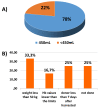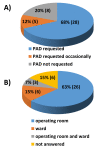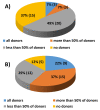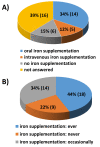A survey on preoperative autologous blood donation policy in bone marrow stem cell donors in Italy
- PMID: 36580031
- PMCID: PMC10335345
- DOI: 10.2450/2022.0134-22
A survey on preoperative autologous blood donation policy in bone marrow stem cell donors in Italy
Abstract
Background: The high safety of homologous blood components, together with the introduction of the Patient Blood Management strategy, has led to the progressive abandonment of preoperative autologous blood donation (PAD) in surgery. Furthermore, recent scientific publications provide evidence about the non-usefulness of PAD in the collection of hematopoietic stem cells (HSC) from bone marrow (BM), also in consideration of harvest procedure safety. Nevertheless, no conclusive studies have been published yet.
Materials and methods: Blood Establishments (BE) and Bone Marrow Collection Centers (BMCC) participated in a specific qualitative survey proposed by Italian National Blood and Transplant centers with the support of the relevant Italian Scientific Societies. The survey aimed at evaluating the policy adopted for PAD in related and unrelated adult HSC donors in Italy during the period 2018-2020.
Results: Forty-one BE corresponding to 37 BMCC filled in the questionnaire. Of 830 BM donors, 661 (80%) underwent 1063 PAD (mean 1.6 PAD/donor). The remaining 169 donors (20%) underwent BM harvest without PAD. No serious adverse events were reported for either donor group. In the case of ineligibility of donors for the PAD program, due to low hemoglobin values, 7/10 centers shifted donors to peripheral blood stem cell collection and three centers chose a different donor. Remarkably, only 51% of the PAD units requested were eventually transfused during the BM harvest process. Finally, the iron support policy among centers was heterogeneous.
Discussion: The results of this survey show that PAD is heterogeneously applied in Italian BMCC, as in other countries. However, all BMCC except two are willing to adopt a Patient Blood Management strategy as an alternative approach to adult related and unrelated BM donor harvests.
Conflict of interest statement
The Authors declare that they have no conflicts of interest.
Figures






Similar articles
-
Patient Blood Management in pediatric and adolescent bone marrow donors: results from an Italian survey.Blood Transfus. 2025 Jul-Aug;23(4):295-303. doi: 10.2450/BloodTransfus.847. Epub 2024 Nov 28. Blood Transfus. 2025. PMID: 39621892 Free PMC article.
-
Preoperative autologous blood donation in adult bone marrow donors: reappraisal of a single-centre experience.Vox Sang. 2019 Oct;114(7):762-768. doi: 10.1111/vox.12834. Epub 2019 Aug 11. Vox Sang. 2019. PMID: 31402471
-
Impact of autologous blood transfusion after bone marrow harvest on unrelated donor's health and outcome: a CIBMTR analysis.Bone Marrow Transplant. 2020 Nov;55(11):2121-2131. doi: 10.1038/s41409-020-0911-8. Epub 2020 Apr 30. Bone Marrow Transplant. 2020. PMID: 32355289 Free PMC article.
-
Recovery and safety profiles of marrow and PBSC donors: experience of the National Marrow Donor Program.Biol Blood Marrow Transplant. 2008 Sep;14(9 Suppl):29-36. doi: 10.1016/j.bbmt.2008.05.018. Biol Blood Marrow Transplant. 2008. PMID: 18721778 Review.
-
Safety of bone marrow stem cell donation: a review.Transplant Proc. 2010 Jul-Aug;42(6):2192-4. doi: 10.1016/j.transproceed.2010.05.029. Transplant Proc. 2010. PMID: 20692441 Review.
Cited by
-
Autologous transfusion requirements in bone marrow harvest: results of the ATREMA study.Blood Transfus. 2024 Jan;22(1):90-92. doi: 10.2450/BloodTransfus.669. Blood Transfus. 2024. PMID: 38276912 Free PMC article. No abstract available.
-
Patient Blood Management in pediatric and adolescent bone marrow donors: results from an Italian survey.Blood Transfus. 2025 Jul-Aug;23(4):295-303. doi: 10.2450/BloodTransfus.847. Epub 2024 Nov 28. Blood Transfus. 2025. PMID: 39621892 Free PMC article.
References
-
- McCullough J, Hansen J, Perkins H, Stroncek D, Bartsch G. The National Marrow Donor Program: how it works, accomplishments to date. Oncology (Williston Park) 1989;3:63–68. discussion 72–74. - PubMed
-
- World Health Organization (WHO) WHO Global Forum for Blood Safety: patient blood management, World Health Alliance Resolution A63. R12. 2010. May, [Accessed on 25/05/2022]. Available at: https://www.who.int/bloodsafety/events/gfbs_01_pbm/en/
MeSH terms
LinkOut - more resources
Full Text Sources
Medical
